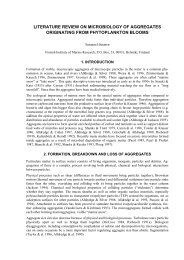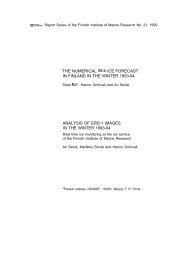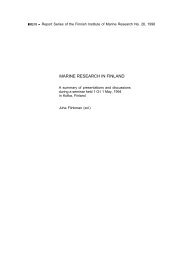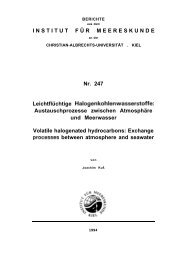BALTIC SEA ENVIRONMENT PROCEEDINGS No. 80
BALTIC SEA ENVIRONMENT PROCEEDINGS No. 80
BALTIC SEA ENVIRONMENT PROCEEDINGS No. 80
- No tags were found...
You also want an ePaper? Increase the reach of your titles
YUMPU automatically turns print PDFs into web optimized ePapers that Google loves.
Further down, the sediment gradually becomes more compact and the friction against the inner wall ofthe coring tube increases. When the corer reaches a depth where the ratio between the wall friction andthe aperture area of the corer becomes critical, the sediment core begins to act partly as a plough and coreshortening begins. Clayey, silty sediments are compressed more than light, unconsolidated, organicsediments, and the beginning of the shortening is related to the corer diameter (Blomqvist, 1992).Exclusionary core shortening typically occurs where relatively stiff, low-porosity sediments overlie azone of soft sediments and the soft sediments are driven aside as the core barrel containing high-densitysediments penetrates deeper (Morton and White, 1997).If recently contaminated particles in the top layer are dragged downwards along the inner wall of thecoring tube and are then found in older, deeper layers than those "in situ", the consequences of thesmearing effect are particularly disturbing in studies of sedimentation rate based on the verticaldistribution of radionuclides. Some intercomparisons have shown that the risk of smearing effect ishigher in corers with small diameters (Aarkrog and Dahlgaard, 1989, Nies et al., 1990), but the problemmight also be related to the consistency of the bottom, the penetration velocity and tilting of the corer.Problems linked with small-diameter gravity corers in the collection of soft and highly porous sedimentshave been discussed in many publications. Baxter et al. (1981) reported that small-diameter gravitycoring and possibly other techniques using heavy and high-velocity devices in unconsolidated surfacesediments can induce extensive loss of material while simultaneously distorting the vertical distributionof sedimentary species of interest. They argued that the extensive sediment loss and mixing processwhich accompanies gravity coring produces quite feasible, and thus particularly misleading, verticalprofiles of chemical parameters, and concluded that a soft-landing hydraulically-damped coring device ismore reliable for such work. However, their results were based on experiments in which the corer wasallowed to free-fall from a few metres above the sediment surface to the bottom. Evans & Lasenby(1984) showed that the deficiency in coring with gravity corers can be attributed to the high velocity atwhich the corers fall through the water column and then enter the sediments, resulting indispersion/blown-away of the surface sediments due to the "shock wave" effect. They tested whethercores taken with a gravity corer making a slow descent into the sediments would give chemical profilessimilar to those taken carefully by Scuba divers, and found that there is no evidence to reject thehypothesis that in soft, recent sediments, "slow impact" gravity cores are comparable to diver cores.To obtain reliable samples, gentle, slow entry and penetration of the coring tube/box into the sedimentare essential in order to prevent loss of the flocculent surface sediments. It is clear that the uppermost softsediments are often seriously disturbed or entirely lost when a free-falling corer is used (Blomqvist,1992).Favourable weather conditions and maximum ship stability are naturally advantageous in obtainingundisturbed and reliable samples. If sampling is performed in a small vessel in shallow waters, anchoringis always recommended before sampling. The attachment wire should be lowered as vertically aspossible, because bias from the vertical results in tilting of the corer. Supplying the corer with asupporting frame may reduce tilting in difficult circumstances.Repenetration of the corer into the sediment may easily lead to misinterpretations. Rolling and pitchingof the vessel may cause a problem when the sampler hits the bottom, resulting in disturbance before thecorer actually enters the sediment (Blomqvist, 1992).The sample may also be disturbed during the corer closing operation or its withdrawal from the sediment,and during retrieval (Blomqvist, 1992). These stages may, therefore, also require careful, gentle work.Rotation of a corer during retrieval causes shear stress on the sediment. Since the rate of motion increaseswith the sample area, large-area instruments tend to produce more disturbance (Blomqvist, 1992). Toavoid rotation, a swivel should always be connected to the wire.











